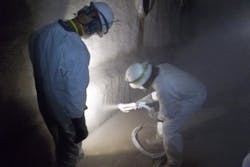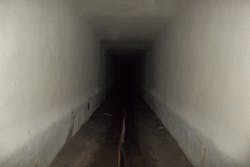GeoSpray Application for Box Culvert System in Memphis
The Overview
In early 2015, the city of Memphis hired an engineering firm to design a rehabilitation solution for the Sears crosstown box culvert system. This inspection included the evaluation of twin 8.5-ft by 8-ft concrete box culverts, each a length of 500 ln ft, that are part of the Madison Heights drainage basin.
A full inspection of the system concluded that the box culverts had severe corrosion, spalling and cracking that were the source of infiltration and inflow, as well as minor corrosion to some of the existing steel structure, but in general, the steel cage of the existing box was still structurally sound. This is typical of most concrete storm water culverts where the true deterioration has affected some level of the steel, but the actual box is still structurally sound.
While considering the options for rehabilitation, the engineering firm determined that slip lining of the box structure with a round pipe would cause too great of a loss of cross-sectional area as well as hydraulic performance in the critical basin area. Dig and replace options were eliminated due to the construction of a building over the existing culvert after its initial installation. The final decision was made to develop a proposal based on a structural enhancement of the existing structure using geopolymer mortar linings.
The Solution
The project was advertised in November 2016 with the option of structural enhancement of the twin box culverts and GeoSpray geopolymer mortar was specified as the approved product. Inland Pipe Rehabilitation LLC (IPR) was awarded the project in early 2017. The design of the box culvert rehabilitation included applying a minimum of 1.5 in. of geopolymer mortar to recover and protect the steel structure as well as fill in voids, cracks and other defects that were allowing water infiltration into the culvert from the surrounding soil.
Once the design was approved by the city and the engineer, work began on the culvert in earnest in early November 2017, after delays in the summer of 2017 due to excessive flooding in the area that made dewatering the culvert impossible. To begin repairing the culvert, all flow had to be diverted into a single side of the culvert. The culvert was pressure washed to remove debris and loosely bonded concrete, and any exposed steel was cleaned and coated. All active infiltration was stopped using hydrophobic grouts. Finally, a 1.5-in. geopolymer coating was applied to the structure starting at the bottom of the vertical walls, moving overhead and finishing the bottom of the culvert.
The Results
The project was completed in early January 2018. The city signed off on the final culvert rehab and this was the second geopolymer project bid in the city in the preceding 18 months.

